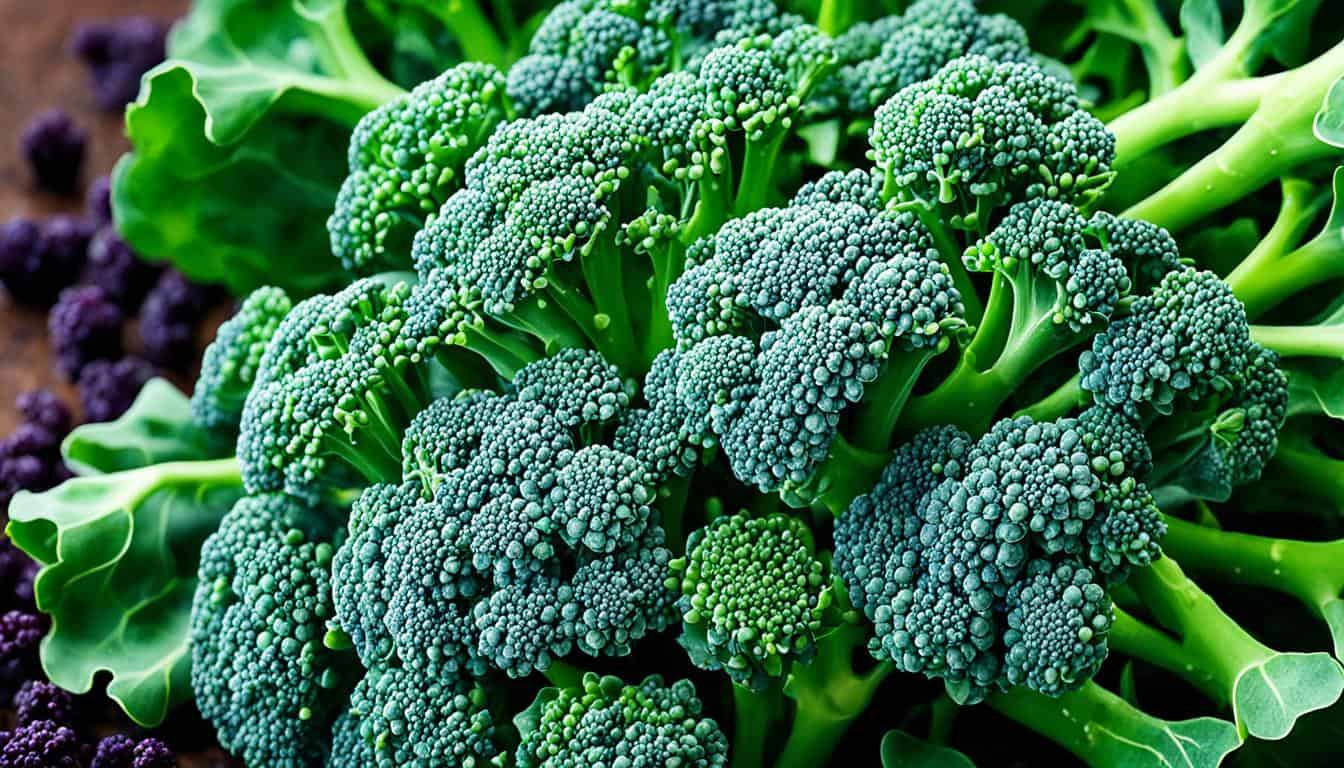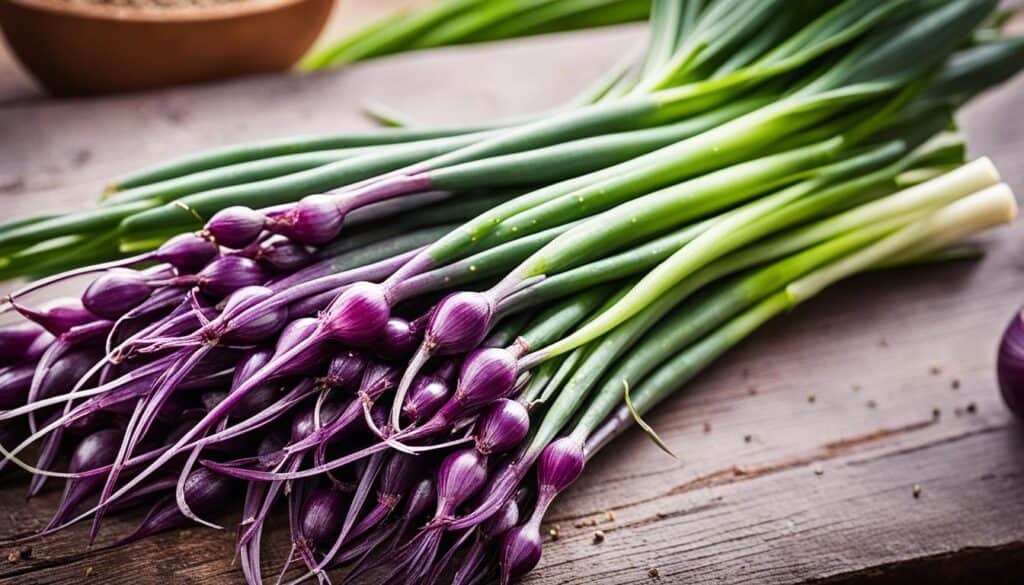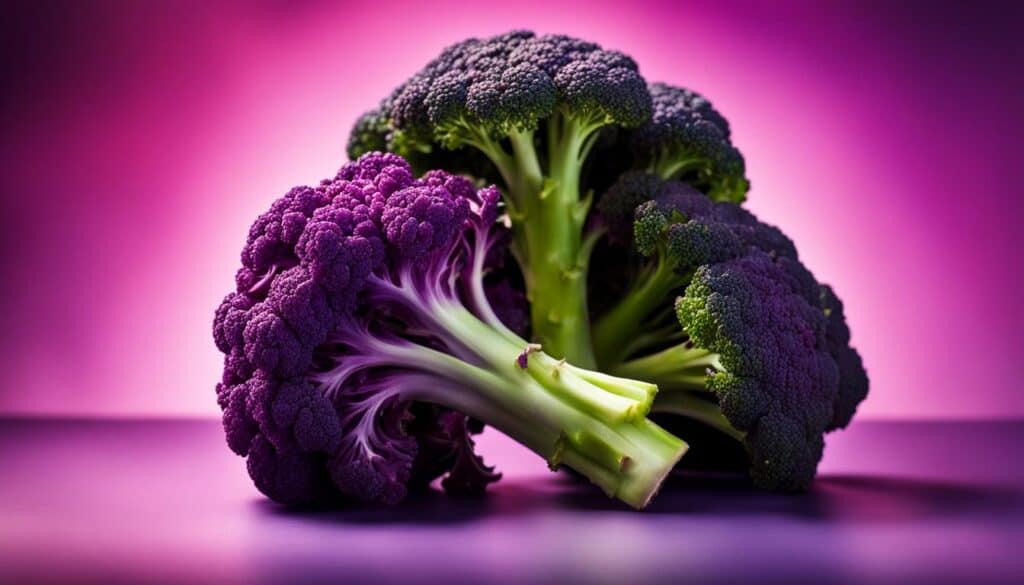Did you know that purple broccoli is not just a vibrant vegetable but also a nutritional powerhouse? Its stunning purple hue is an indication of the potent health benefits it offers. Purple broccoli, along with other purple vegetables such as purple carrots, sprouting broccoli, purple spring onions, blue salad potatoes, and purple magnolia sugar snap peas, is rich in antioxidants called anthocyanins, which have a range of positive effects on our well-being.
Key Takeaways:
- Purple broccoli is packed with antioxidants called anthocyanins.
- Anthocyanins contribute to reducing inflammation in the body.
- Purple vegetables offer a variety of health benefits for cardiovascular health, immune function, and healthy skin.
- Incorporating purple vegetables into our diet can be as simple as adding them to salads, roasting them as side dishes, or using them in stir-fries.
- By exploring different cooking methods, we can maximize the nutritional benefits of purple vegetables.
The Health Benefits of Purple Carrots
Purple carrots, with their deep purple hue, contain high levels of anthocyanins and beta-carotene. These compounds have been found to support eye health and vision, enhance immune function, and contribute to healthy, radiant skin. Incorporating purple carrots into our diet is an easy way to reap these health benefits.
Anthocyanins, the pigments responsible for the vibrant purple color, are powerful antioxidants that help protect our cells from damage caused by free radicals. They play a crucial role in maintaining the health of various organs in our body, including our eyes, immune system, and skin.
| Health Benefit | How Purple Carrots Contribute |
|---|---|
| Eye Health and Vision | Purple carrots are rich in beta-carotene, a precursor to vitamin A, which is essential for good vision. Beta-carotene is converted into retinol, a form of vitamin A that supports eye health, prevents night blindness, and may reduce the risk of age-related macular degeneration. |
| Immune Function | The anthocyanins found in purple carrots have anti-inflammatory properties that can help enhance immune function and protect against infections. They support the production of immune cells and strengthen the body’s defense mechanisms. |
| Skin Health | Anthocyanins and other antioxidants present in purple carrots help protect the skin from oxidative stress, which can lead to premature aging and skin damage. These antioxidants support collagen production, improve skin elasticity, and promote a healthy glow. |
Incorporating purple carrots into our meals is simple and versatile. We can enjoy them raw in salads, roast them as a side dish, or use them in soups and stews for added color, flavor, and nutritional benefits. By adding purple carrots to our regular vegetable rotation, we can support our eye health, boost our immune system, and promote vibrant and youthful skin.
The Advantages of Purple Sprouting Broccoli
Purple sprouting broccoli, with its deep purple hue, is a nutritional powerhouse that offers a wide range of benefits for our health. This vibrant vegetable is not only visually appealing but also packed with essential nutrients and powerful antioxidants.
One of the key components that make purple sprouting broccoli unique is its high anthocyanin content. Anthocyanins are a type of antioxidant that are responsible for the vibrant purple color of this broccoli variety. These antioxidants have been found to possess anti-inflammatory properties, which can help reduce inflammation in the body.
Inflammation is a natural response that occurs when the body is injured or under attack. However, chronic inflammation has been linked to the development of various diseases, including cardiovascular conditions. By incorporating purple sprouting broccoli into our diet, we can potentially support cardiovascular health and reduce the risk of heart disease.
In addition to its anti-inflammatory properties, purple sprouting broccoli also provides a range of other health benefits. It is a good source of vitamins, minerals, and fiber, which are essential for overall well-being. The fiber content in this broccoli variety can aid in digestion and promote bowel regularity.
Moreover, purple sprouting broccoli contains bioactive compounds that contribute to its health-boosting effects. These compounds, including glucosinolates, have been studied for their potential anti-cancer properties. They may help lower the risk of certain types of cancers, such as colorectal and gastric cancers.
To fully appreciate the nutritional benefits of purple sprouting broccoli, it’s important to include it in our meals regularly. Whether steamed, roasted, or stir-fried, purple sprouting broccoli adds a delightful color, flavor, and texture to a variety of dishes. Its tender florets and stalks are not only visually appealing but also enjoyable to eat.
So why not explore the vibrant world of purple sprouting broccoli and discover new ways to incorporate this nutritious vegetable into your diet? Indulge in its earthy flavor and reap the numerous health advantages it offers.
Purple Sprouting Broccoli Nutritional Profile
| Nutrient | Amount per 100g |
|---|---|
| Energy | 28 kcal |
| Protein | 3.2g |
| Fat | 0.7g |
| Carbohydrate | 4.4g |
| Fiber | 3.7g |
| Vitamin C | 89mg |
| Vitamin K | 101.6µg |
| Potassium | 316mg |
| Calcium | 47mg |
| Iron | 0.7mg |
The Benefits of Purple Spring Onions
When it comes to enhancing the flavor of our meals, purple spring onions are a popular choice. But did you know that these vibrant vegetables also offer numerous health advantages? Rich in anthocyanin antioxidants, purple spring onions have been linked to the reduction of inflammation in the body, which can have a positive impact on various chronic conditions.
Anthocyanins, the pigments responsible for the purple color of these onions, possess anti-inflammatory properties that help combat inflammation in the body. By reducing inflammation, these compounds may contribute to the prevention of chronic conditions such as cardiovascular disease, diabetes, and certain types of cancer.
Moreover, research suggests that anthocyanins play a role in improving blood circulation and reducing oxidative stress. These beneficial effects can further contribute to overall health and well-being.
How to incorporate Purple Spring Onions into Your Diet
Purple spring onions can be a versatile addition to a wide range of dishes – both raw and cooked. Here are a few simple ideas to enjoy the taste and health benefits of purple spring onions:
- Add thinly sliced purple spring onions to salads for an extra burst of color and flavor.
- Include them in stir-fries or sautés to elevate the taste and add a vibrant touch.
- Use them as a topping or garnish on soups, stews, or roasted vegetables to enhance the overall presentation.
By incorporating purple spring onions into your meals, you can not only elevate the taste but also support your body’s inflammation reduction and overall health.
“Purple spring onions add a delightful twist to my favorite stir-fry recipes. Not only do they bring a beautiful color to the dish, but their subtle onion flavor enhances the overall taste. Knowing that I’m also getting the benefits of inflammation reduction makes them a staple in my kitchen.”
– Jane, culinary enthusiast
To fully appreciate the versatility and health advantages of purple spring onions, it’s important to explore different cooking methods and recipes. Whether they’re a colorful addition to a salad or a flavorful element in a stir-fry, purple spring onions can be enjoyed in various ways.
Inflammation Reduction and Chronic Conditions
Reducing inflammation in the body is crucial, as chronic inflammation has been linked to the development of various chronic conditions, including:
| Conditions | Role of Inflammation |
|---|---|
| Cardiovascular Disease | Chronic inflammation can contribute to the progression of atherosclerosis, which increases the risk of heart attacks and strokes. |
| Diabetes | Inflammation plays a role in insulin resistance and the development of complications associated with diabetes. |
| Certain Types of Cancer | Chronic inflammation can promote the growth and spread of cancer cells. |
By incorporating purple spring onions into your diet and benefiting from their anthocyanin content, you can potentially reduce inflammation and mitigate the risk of these chronic conditions.
As with all dietary choices, it’s important to incorporate purple spring onions as part of a balanced and varied diet, accompanied by regular exercise and other healthy lifestyle habits. By doing so, you can take advantage of the health benefits that purple spring onions have to offer and support your overall well-being.
The Delights of Blue Salad Potatoes and Purple Magnolia Sugar Snap Peas
I am constantly on the lookout for vibrant and flavorful ingredients to elevate my culinary creations. Blue salad potatoes and purple magnolia sugar snap peas have quickly become two of my favorite additions to any dish. Not only do they bring exciting colors to the plate, but they also offer potential benefits for cognitive health and brain function.
What makes these vegetables truly unique are the anthocyanins they contain. Anthocyanins are a type of antioxidant that gives the potatoes and peas their striking blue and purple colors. These antioxidants have been linked to various health benefits, particularly in relation to cognitive health and brain function.
Studies have suggested that anthocyanins may have a positive impact on brain health. They have been associated with improved memory, enhanced focus, and reduced cognitive decline. By incorporating blue salad potatoes and purple magnolia sugar snap peas into your diet, you provide your brain with a dose of these beneficial compounds.
“Anthocyanins, found in blue salad potatoes and purple magnolia sugar snap peas, have shown potential in supporting cognitive health and brain function.”
Not only are blue salad potatoes and purple magnolia sugar snap peas beneficial for the brain, but they also add a burst of flavor to any dish. The delicate sweetness of the peas perfectly complements the earthy notes of the potatoes, creating a harmonious balance of tastes.
To fully savor the delights of blue salad potatoes and purple magnolia sugar snap peas, I love experimenting with various recipes. From roasted vegetable medleys to colorful salads, the possibilities are endless. One simple yet delectable option is to toss the potatoes and peas together with a drizzle of olive oil, some minced garlic, and a sprinkle of sea salt. Roast them in the oven until tender and enjoy a dish bursting with flavors and vibrant colors.
Discover the wonders of blue salad potatoes and purple magnolia sugar snap peas in the table below:
| Vegetable | Color | Taste | Benefits |
|---|---|---|---|
| Blue Salad Potatoes | Blue | Earthy | High in anthocyanins, beneficial for cognitive health and brain function |
| Purple Magnolia Sugar Snap Peas | Purple | Delicately sweet | Rich in anthocyanins, potential benefits for cognitive health and brain function |
So the next time you want to add a pop of color and flavor to your meals while supporting your cognitive health, give blue salad potatoes and purple magnolia sugar snap peas a try. Your taste buds and brain will thank you!
Practical Ways to Enjoy Purple Vegetables
When it comes to incorporating the benefits of purple vegetables into our diet, the possibilities are endless. These vibrant and nutritious veggies can be enjoyed in various delightful dishes that not only look visually appealing but also provide a burst of flavor and antioxidants.
If you’re looking to add a touch of purple to your salads, try combining purple spring onions, blue salad potatoes, and purple magnolia sugar snap peas. This colorful combination will not only elevate the visual appeal of your salad but also provide a range of antioxidants and nutrients.
For visually stunning side dishes, consider roasting purple carrots alongside blue salad potatoes and purple sprouting broccoli. The combination of these purple veggies will not only add a vibrant and inviting color to your plate but also offer a wide array of health benefits.
If you prefer stir-fries, incorporating purple spring onions, purple magnolia sugar snap peas, and purple sprouting broccoli will not only infuse your dish with a burst of color but also provide a generous dose of antioxidants. These purple vegetables will not only enhance the flavor but also contribute to overall well-being.
These practical and creative ways to enjoy purple vegetables will not only add excitement to your meals but also provide the numerous health benefits associated with these vibrant veggies. So, don’t be afraid to experiment with purple vegetable recipes and discover the delicious possibilities they offer!
The Remarkable Nutritional Profile of Broccoli
Broccoli, a member of the cruciferous vegetable family, is a nutritional powerhouse. Packed with vitamins, minerals, fiber, and antioxidants, broccoli offers a wide range of health benefits.
Let’s dive into the impressive array of nutrients found in broccoli:
| Nutrient | Amount per 100g |
|---|---|
| Vitamin C | 93.2mg |
| Vitamin A | 623IU |
| Vitamin K | 101.6mcg |
| Vitamin B9 (Folate) | 63mcg |
| Potassium | 316mg |
| Phosphorus | 66mg |
| Selenium | 0.4mcg |
These nutrients play essential roles in maintaining overall health. Vitamin C supports a healthy immune system, while vitamin A contributes to good vision. Vitamin K aids in blood clotting, and vitamin B9 (folate) is important for cell growth and development. Potassium helps regulate blood pressure, and phosphorus is vital for bone health. Selenium acts as an antioxidant, protecting cells from damage.
In addition to these key vitamins and minerals, broccoli contains bioactive compounds such as antioxidants. These compounds combat harmful free radicals in the body, reducing inflammation and promoting well-being.
Broccoli is also an excellent source of dietary fiber, which supports digestive health and helps maintain a feeling of fullness. The fiber content of broccoli aids in healthy digestion and can contribute to weight management.
Overall, the exceptional nutritional composition of broccoli makes it a valuable addition to any diet. Its abundance of vitamins, minerals, fiber, and antioxidants offers numerous health benefits and contributes to overall well-being.
Take a look at the nutritional profile of broccoli in the table below:
The Potential Health Benefits of Broccoli Consumption
When it comes to promoting overall health and well-being, broccoli has long been recognized as a nutritional powerhouse. Packed with essential vitamins, minerals, fiber, and antioxidants, broccoli offers a wide range of potential health benefits that make it a valuable addition to any diet.
One of the key advantages of consuming broccoli is its ability to reduce inflammation in the body. Chronic inflammation is a common underlying factor in many health conditions, including heart disease, diabetes, and arthritis. By including broccoli in your meals, you can help combat inflammation and promote optimal health.
“Broccoli contains bioactive compounds that have been shown to reduce inflammation and support overall health.” – Nutrition Research Study
Another remarkable benefit of broccoli is its potential for cancer prevention. Studies have shown that the unique combination of antioxidants and phytochemicals found in broccoli can help protect against various types of cancer, including breast, prostate, gastric, colorectal, renal, and bladder cancers. Regular consumption of broccoli may play a role in reducing your risk of these deadly diseases.
“The consumption of cruciferous vegetables, such as broccoli, has been associated with a lower risk of cancer.” – International Journal of Cancer Research
Furthermore, incorporating broccoli into your diet can contribute to improved heart health. This cruciferous vegetable has been found to lower cholesterol levels and decrease the risk of heart attack, thanks to its fiber content and unique bioactive compounds. By enjoying broccoli regularly, you can support a healthy heart and reduce your chances of cardiovascular disease.
“Broccoli consumption can lower cholesterol levels and reduce the risk of heart disease.” – American Journal of Clinical Nutrition
Not only does broccoli offer benefits for inflammation, cancer prevention, and heart health, but it also plays a crucial role in digestion. The fiber content in broccoli promotes bowel regularity and helps maintain healthy gut bacteria, supporting a well-functioning digestive system. By including broccoli in your meals, you can aid digestion and promote a healthy gut.
“Broccoli is a rich source of fiber, which promotes bowel regularity and helps maintain a healthy gut.” – Journal of Gastroenterology
| Health Benefits of Broccoli | Scientific Evidence |
|---|---|
| Reduced inflammation | Nutrition Research Study |
| Cancer prevention | International Journal of Cancer Research |
| Improved heart health | American Journal of Clinical Nutrition |
| Enhanced digestion | Journal of Gastroenterology |
By regularly consuming broccoli, you can enjoy these potential health benefits and nourish your body with its incredible nutrient profile. Whether steamed, sautéed, or added to your favorite recipes, broccoli is a versatile and delicious vegetable that deserves a prominent place on your plate.
The Effects of Cooking on Broccoli’s Antioxidant Properties
Cooking methods play a significant role in determining the antioxidant properties of broccoli. The way we cook broccoli can either preserve or diminish its valuable antioxidants. Let’s explore the impact of boiling and microwaving on the antioxidant content of broccoli and understand the importance of choosing the right cooking method.
Boiling vs. Microwaving
Boiling broccoli in water can lead to a leaching effect, causing the loss of antioxidants. The water-soluble antioxidants present in broccoli can escape into the cooking water, resulting in a reduced antioxidant content in the cooked broccoli.
On the other hand, microwaving broccoli has been found to be a more favorable cooking method in terms of retaining and even enhancing the antioxidant content compared to boiling. Microwaving allows for quicker cooking, which minimizes the exposure of broccoli to heat, helping to retain more of its beneficial antioxidants.
| Cooking Method | Effect on Antioxidant Content |
|---|---|
| Boiling | Leads to a leaching effect and reduction in antioxidant content |
| Microwaving | Retains or enhances antioxidant content compared to boiling |
It’s important to note that the cooking time also plays a role in determining the antioxidant retention in broccoli. Overcooking broccoli, regardless of the method, can result in a loss of antioxidants. Therefore, it’s recommended to cook broccoli until it is lightly cooked and still retains its vibrant green color.
Additionally, it’s worth mentioning that purple-sprouting broccoli, with its higher anthocyanin content, may be more sensitive to cooking treatments. Therefore, using gentle cooking techniques such as steaming or microwaving can help preserve the antioxidant properties of purple-sprouting broccoli to a greater extent.
By choosing the right cooking method and being mindful of the cooking time, we can maximize the nutritional value of broccoli and ensure that we reap the benefits of its antioxidants.
Conclusion
Purple vegetables, such as purple broccoli, are packed with essential nutrients and offer a myriad of health benefits. Their vibrant colors are not just visually pleasing but indicative of the antioxidants they contain. From purple carrots supporting eye health to purple sprouting broccoli promoting cardiovascular health, incorporating purple vegetables into our diet can be a delicious way to nourish our bodies.
By exploring different cooking methods, we can retain the nutritional benefits of purple vegetables. Whether roasting purple carrots or stir-frying purple spring onions, the possibilities are endless. These cooking techniques help preserve the antioxidant content, ensuring we reap the maximum benefits from these colorful vegetables.
Including purple vegetables, such as purple broccoli, in our meals is a simple yet effective way to boost our overall well-being. Their high antioxidant content not only helps fight inflammation but also supports immune function, cardiovascular health, and healthy skin. So, let’s embrace the vibrant hues of purple vegetables and make them a staple in our diet for optimal health.










Leave a Reply